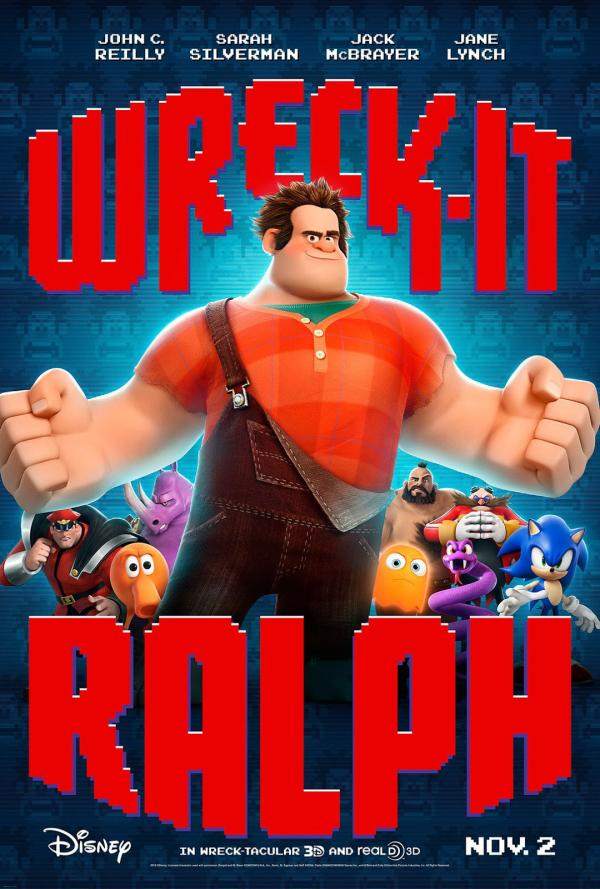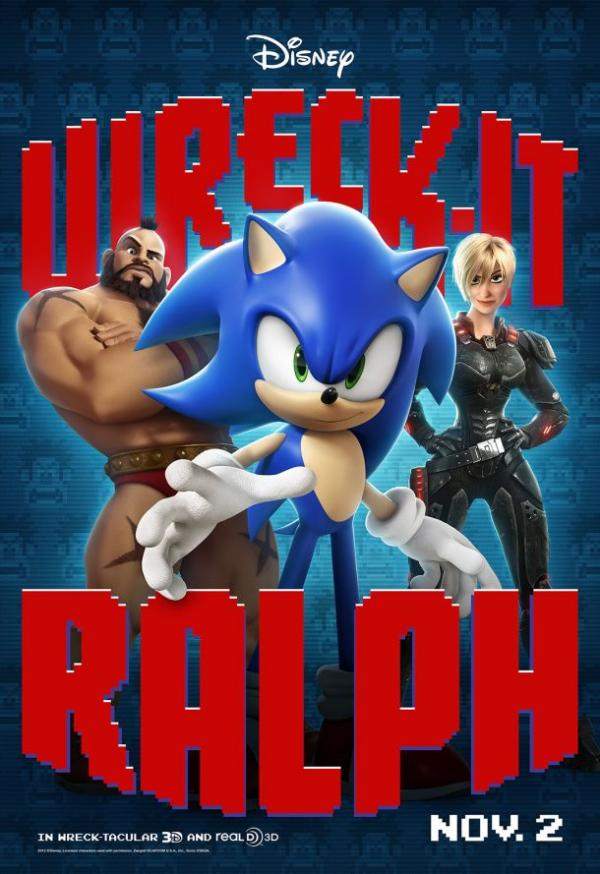
In Wreck-It Ralph, our title character is a villain in a 30 year old game along one wall of Litwak’s Arcade.
Much like Toy Story before it, the action of the story takes place when the people are away. Whenever these machines are not being played, their characters are free to roam, even from game to game.
After a particularly bad day of being reminded how much he hates his job, Ralph leaves to find something more. He wants to be a hero, which to him is represented by the acquisition of gold medals, the way the ‘good guy’ of his own game, Fix-it Felix Jr., does, daily.
Most of the story’s action occurs in one of the neighboring game cabinets, Sugar Rush, a Mario Kart style racing game featuring a candy and desert theme.
Thus the film is filled to bursting with bright colors and sugary puns. More entertaining, however, is all of the gaming references. From old arcade games to modern console and PC titles, every scene has some nugget for video game fans, most of them buried in the wordplay of the dialog or in the background scenery. In addition, all of the games in the arcade, other than the ones that the major characters of the plot come from, are actual games from our past and present. While some of them don’t quite make sense, considering that they were not arcade titles, for example: Sonic the Hedgehog, the subtle geek culture humor is well delivered, and very satisfying.
The characterizations are also compelling. Each of the characters has a clear motivation and background, despite being fully aware that they are characters in video games – they can even see out of the screens of the cabinets to the players at the controls – they have all been ‘programmed’ with backstories and personalities that make them surprisingly deep.
Especially interesting is the way Felix is used. One expects that typically in stories like this one, where a ‘bad guy’ is being shown to be just a regular guy dealt a poor hand, the ‘good guy’ will be shown as a real jerk, a rival to the true protagonist, if not an outright villain. However, Felix is a likable and sympathetic character in his own right, and while he has some developing to do while he discovers what the world has been like for Ralph over the last 30 years, he’s not malicious, and it’s easy to empathize with his plight as he heads off in search of his bad guy.

In addition, the world itself has surprisingly deep lore. The arcade has been around for a long time, and these characters have a community all their own, with a culture and a history, morals and legends, even their own jargon.
That well-built lore is delivered not through overbearing exposition, but is shown to us from within the characters’ travels and interactions.
Some of it is a bit deviced tell-the-ancient-legend-to-the-ignorant-new-guy type stuff, but most of the rules and lore of this verisimilar world are shown through simple interactions or background elements, like the PSA staring Sonic which warns the arcade population about dying outside of one’s own game cabinet, where they will be unable to respawn.
The detail is gathered from the background as the protagonist walks through Game Central Station – a surge protector that all of the arcade games are plugged into.
All that was expected, though. It’s Disney after all. We’ve seen what they can do in the past, and we knew that they were capable of this kind of quality, even if some of Pixar’s titles have been lacking recently. What took me off guard was the raw emotional strength of the story itself. Ralph’s tale of exploration, introspection, redemption, and finally, acceptance is a moving one. It was more emotional, more powerful than anything I’ve seen so far this year, and that’s not hyperbole. It may not have had the pure special-effects or the stark and rousing fight-action of some of this year’s big super hero films, but it cannot be beaten for raw emotional delivery.
I’d been looking forward to this film since the first teasers arrived, and I went in fully expecting to be entertained, and to be one of the few people in the theater who got all of the obscure video gaming references. I did not expect my heart to be tugged, my tears to be jerked, or my spirits to be raised, but it happened.
After a few missteps in last decade, Disney has shown with Wreck-It Ralph that they still know how to tell a great CGI story. I don’t say this lightly: If you’re only taking your family, geeky or otherwise, to one film this holiday season, you’ve got to make it to Wreck-It Ralph. I can safely and confidently recommend the film for all ages and walks of life, but I’m declaring required viewing for anyone steeped in the video gaming culture, or anyone who once was.
Wreck-It Ralph is in theaters now in 3D or regular-D.







